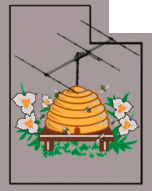|
Northern
Utah
WebSDR landing page
sdrutah.org
Club callsign: kd7efg
|
The
Northern Utah
WebSDR's servers
may be found at the
links below:
Receivers using omnidirectional
antennas
- WebSDR1
("Yellow")
- Covers the 2200, 630,
160, 80/75,
60
and 40
meter amateur bands, AM
broadcast, the 120,
and 60
meter shortwave
broadcast bands and the 1750 meter LowFER band.
- WebSDR2
("Green")
- Covers the 30,
20,
17,
15,
12,
10
and 6
meter (bottom 1 MHz)
amateur bands.
- WebSDR3
("Blue")
- Covers the 80/75, 40, 30
and 2 meter
amateur bands and the 90,
60, 49, 41, 31, 25
and 19
meter shortwave
broadcast bands.
- This server also serves as a back-up
for WebSDR1's coverage of the very popular 80/75 and 40 meter amateur
bands using lower-performance receivers.
- The 60/49 meter receiver
also covers the 60 meter amateur band.
Receivers using the east-pointing
beam (eastern U.S. and Canada, Africa)
- WebSDR4 ("Magenta")
- Covers the 40, 30, 20,
17, 15, 12
and 10
meter amateur bands using an east-pointing
beam antenna.
- For phones and tablets, there is a
simplified, mobile Version of WebSDR #4.
Receivers using the
northwest-pointing beam (U.S. West Coast, Alaska, Asia,
Oceana)
- WebSDR5 ("Teal")
- Covers the 30, 20,
17, 15, 12
and 10
meter amateur bands using an northwest-pointing
beam antenna.
- For phones and tablets, there is a
simplified, mobile Version of WebSDR #5.
Local VHF/UHF receivers near Salt
Lake City (plus Earth to Space)
- Salt
Lake Metro VHF/UHF ("Peach")
- This covers the Salt Lake City, Utah area from a location in the
foothills along the east side of the valley and has coverage on the 2
meter and 70 cm amateur bands, a 2 MHz swath of the "Aircraft" band,
and the bottom 1 MHz of the 6 meter amateur band.
|
|
The 2021/2 Survey results are now
available:
Many thanks to those who
took the time to participate in the 2021/2 survey: Your
feedback helps us improve the system - An analysis of the results
may be found here. |
|
Having trouble getting
WebSDR audio on some Apple devices?
If you are running an APPLE
device and/or
using the CHROME
browser, make sure that you click on the START button, above and to the
right of the waterfall.
Having said that, there are occasional reports that users running Apple
iOS 13 have have trouble getting audio on WebSDRs and KiwiSDRs.
While changes have been made to the Northern Utah Utah
WebSDRs to fix
an
issue that had prevented the "iOS Audio Start" button from appearing,
but it may not work in all cases.
- Possible
"no sound on iOS 13" work-around if the "START" button does not work:
- The configuration change below has been
reported to work for at least some
users of iOS 13 devices using the Safari. Do this
ONLY if you don't get
either audio or the "iOS Audio Start" button when using your iOS 13
device.
- Go
to: Settings -> Safari -> Request Desktop
Website -> All websites.
- "All
websites" is enabled
by default. Disable
this setting and try your favorite WebSDR systems.
- If the above doesn't help, READ HERE
and HERE for
more information about this issue.
If you discover issues that you might think are related to browser
compatibility, please
let us know via the contact information on the "About
this WebSDR and contact info"
page.
|
|
Other
WebSDR systems
For different geographical coverage, here are a
few selected
WebSDRs:
Western U.S.:
- KFS,
Half-Moon
Bay, CA 80, 60, 40, 30, 20, 17, 15 and 10
meters.
This is the
best alternative
to the Northern Utah SDR for "local" (e.g. Western U.S.)
coverage.
- W7NRA, Phoenix, AZ
- KiwiSDR (Limited number of users).
Eastern
U.S.:
- K3FEF
& W3TKP , Milford, PA - 2 Servers:
- K3FEF/W3TKP
HF/SWBC- 7 bands that
include amateur and
broadcast on the MW/160, 90/80,
60/49/41/40, 31/30, 25/22, 20/19
and 17 meter bands.
- K3FEF/W3TKP
VHF - 6 bands that include much of 10 meters, a
portion of 6 meters and 2 meters
- NA5B
near
Washington DC - 2 Servers:
- NA5B
HF/SWBC: - 8 bands that
include amateur and
broadcast on the MW/160,
90/80, 60/49/41/40, 31/30, 25/22,
20/19, 15/13
and 11/10 meter bands
- NA5B VHF:
4 bands that include: 6 Meters (50-52 MHz), Air band (119-121 MHz), 2 meters (approx. 145.35-147.40) and NOAA Weather Radio (approx. 162.1-163.9 MHz).
For
a complete
list of WebSDR systems worldwide, go to the websdr.org page.
|
|
Other things going on at the
Northern Utah WebSDR
In addition to the WebSDR receivers, there are a few other things going
on at the Northern Utah WebSDR, including:
- KiwiSDR
receivers.
These are stand-alone HF receivers capable of tuning from
near DC
to 30 MHz, continuously, and are capable not only decoding normal
"voice" modes (USB,
LSB, AM, FM) but they also have the capability of decoding
other types of signals - including RTTY, FAX, SSTV (Slow-Scan TV), and
decode CW. These receivers are also part of a TDOA (Time Direction of Arrival)
network that allow the approximate locations of received signals to be
determined.
- Please
note that these receivers can only support a few users at
a time so please
refrain from using them when receiving on a frequency/mode that is
already supported by the main WebSDR system!
- For more information about the KiwiSDRs, read
HERE (link).
- KiwiSDRs 1-3 are connected to the
omnidirectional antennas while KiwiSDRs 4 and 5 are connected to the
east-pointing beam and Kiwi #6 is connected to the northwest-pointing
beam..
- To visit a KiwiSDR at the Northern Utah
WebSDR:
- Click here
to connect to a KiwiSDR connected to the omni antenna (KiwiSDRs 1, 2 and 4).
These
KiwiSDRs cover from a few kHz to 30 MHz. Coverage below
approx.
400 kHz is via an E-field whip and above this is via the TCI-530
omnidirectional antenna.
- Click here
to connect to a KiwiSDR connected to the east-pointing beam antenna (KiwiSDRs 3 and 5).
These
KiwiSDRs cover from about 6 MHz to 30 MHz owing to the limitations of
the beam antenna: Coverage below 6 MHz is possible, but there
will be little/no directivity and
sensitivity is increasingly poor with lower frequency.
- Click here
to connect to a KiwiSDR connected to the northwest-pointing beam
antenna (KiwiSDR 6).
This
KiwiSDR covers over from about 10 MHz to 30 MHz owing to the
limitations of
the beam antenna: Coverage below 10 MHz is possible, but
sensitivity is increasingly poor with lower frequency.
- Again, please refrain from using
a KiwiSDR to listen to a frequency/mode already supported by the main
WebSDR system.
- "All
band" WSPRNET monitoring. Using
the KiwiSDRs in conjunction with scripts running on another local
machine there are virtual receivers monitoring the WSPR bands on all LF, MF
and HF amateur bands
(e.g. 2200, 630, 160, 80, 60, 40, 30, 20, 17, 15, 12 and 10 meters)
using the callsigns "KD7EFG" and "KD7EFG-1". These receivers
are using the
excellent antenna system on site to receive, decode and contribute WSPR
spots and forward that information to the WSPRNET (link)
web site where the results are aggregated and made publicly available.
This same data is made avaiable to the PSWS (Personal Space Weather System)
associated with HamSCI.
- CW
Skimmer operations.
CW skimmers also operate in the CW portions of the 630, 160,
80,
60, 40, 30, 20, 17, 15, 12, 10 and 6 meter bands using the callsign
"KD7EFG".
- HF
Noise monitoring. Also
using the KiwiSDRs as well as an RX-888 - and related to the WSPRNET
monitoring - the HF
noise floor is also being monitored at this site. The results
of
this may be analyzed to discern band openings, the influences of the
sun's activity, lightning static - and perhaps a few other things
related to HF propagation and the Earth's geomagnetic field.
Results of this monitoring may be seen at the following links:
- Grafana Noise Dashboard
- This link automatically selects the Northern Utah WebSDR
system and the 10, 20, 40, 80 and 630 meter bands - use the
drop-down menus to select specific bands and/or receivers of
interest.
- WSPRdaemon
- This site provides at-a-glance graphs of noise plots on the
participating bands and receive sites.
- This same data is made avaiable to
the PSWS (Personal Space Weather System -
link
to map of stations) associated with HamSCI
- the Ham Radio Science Citizen Investigation. This
organization
helps in the gathering of observations and making it available to the
scientific community - or anyone else - where it contributes
to real
research about our Earth-Space environment.
|
|
|



